| |
"Surely the most immoral thing in any form of entertainment is the conditioning of the audience to accept and enjoy violence? Violence is horrible, degrading, and sordid. Insofar as one is going to show it on screen at all, it should be presented as such – and the more people it shocks into sickened recognition of these facts the better." |
| |
Michael Reeves |
| |
"I admire David Lean, but if you can't make a good film on his budgets, then you have no business being a film director . . . I think one of the really great things about Mike . . . is that he produced three movies for under two hundred thousand pounds. Three movies!" |
| |
Nicky Henson |
Witchfinder General (1968) is a cult classic that tells the true story of the witch-hunt conducted by Mathew Hopkins in East Anglia, during the English Revolution. An air of myth and mystery hangs over the film, partly due to its subject matter, and partly, too, because its 25 year-old director, Michael Reeves, died of a drug overdose just weeks after completing it. His death robbed cinema of a precocious and prodigious talent. Although generally labelled a horror film, the film transcends genre and expertly sidesteps easy classification. It can equally well be described as a dark romance, an action-adventure romp, an historical drama and, even, an English Western. Veteran critic Derek Malcolm included Witchfinder General among his 100 favourite films, in a list compiled to mark the centenary of cinema. He called it "One of the most compulsively watchable films ever made in Britain."

The film's concern for historical authenticity, its artful cinematography and its anger at religious hypocrisy are all evident in a cold open that instantly establishes tension while introducing a recurring motif: the contrast between a benign, innocent landscape and humankind's capacity for cruelty. A cross of light pierces the branches of a swaying tree. As the camera pans across rolling countryside the soothing sounds of sheep and birds are gradually drowned by an insistent knocking noise. A gallows is being erected. A woman is dragged, screaming, through village streets, across lush fields, to a hill dominated by the grisly wooden edifice. The terrified woman faints, is woken by water, then dragged to her doom. As the villagers look on and a priest incants, the stool is kicked from under her. Her screaming stops. The gallows creak with her weight. The wind whispers of her death. The camera pulls out from the woman's swinging corpse to two onlooking figures on horseback. It is our first sight of Mathew Hopkins (Vincent Price) and his sadistic lackey, John Stearne (Robert Russell). It is a brilliantly executed and memorable opening.
That chilling opening scene is followed by the series of stark, black and white stills that accompany the opening credits; some are abstract and indecipherable, mere mysterious shapes, others show people in pain or laughter. The overall effect is as disturbing and disorientating as that produced by the images of faces engulfed in flames that preceded Channel 4's World at War series. It is already obvious that this film is no mere exploitation horror flick. That becomes more obvious when a narrator announces that "The year is 1645" and delivers a reasonably accurate sketch of the circumstances of the day, circumstances which generate the particular atmosphere of Witchfinder General. As the narrator suggests, before the formation that year of the New Model Army as a national army, most of the fighting of the time consisted of low-level, scattered skirmishes between garrison forces. Soldiers pillaged and plundered, houses and horses were commandeered, livestock was slaughtered, suspicion and fear stalked the land, the legal process had all but ceased to function, and chaos reigned.
Witchfinder General brilliantly recreates that sense of social collapse. Such circumstances created the perfect breeding ground for witch-hunts and witchfinders: established ideas and the established order were being challenged, the widespread violence and political turmoil of the time provided cover for the settling of old scores. Among the complex cocktail of ingredients that underpinned witch-hunts were mass hysteria, a heightened misogyny linked to repressed Puritan sexuality, the susceptibility of children and a desire for scapegoats. Marina Warner, who has written extensively about witch-hunts, says: "It is belief in the devil that creates the mischief," a statement as true of Hopkins' reign of terror as of the Salem and McCarthy witch-hunts.
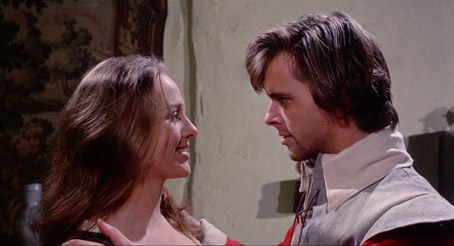
As the film proper begins, a Roundhead cavalry detail approaches, the Venetian red of their uniforms contrasting beautifully with the sun-dappled greenery of the surrounding landscape. In a woodland glade the Ironsides are ambushed by Royalist snipers. The film's hero, Richard Marshall (Ian Ogilvy), saves the life of his commanding officer, Captain Gordon (Michael Beint), by shooting one of the snipers. By way of reward Marshall is granted two days' leave to visit his intended bride Sarah Lowes (Hilary Dwyer) and is promoted to the rank of cornet. Richard rides to Brandeston where Sarah's father, the amiable local priest John Lowes (Rupert Davies), grants him permission to marry her. After a tender love scene, Sarah tells Richard that villagers have accused her and her father of papacy, idolatry and worse. Richard promises that no harm will come to her, wishes her a fond farewell and then returns to his regiment.
On his way out of Brandeston (site of a real witch-hunt in 1645) he encounters Mathew Hopkins and John Stearne who, unbeknownst to him, are on their way there to hunt 'witches'. When it becomes plain to Sarah that Hopkins intends to kill her father she gives herself to Hopkins, in the hope that he will spare her father's life. Having been defiled by Hopkins, Sarah is subsequently raped by Stearne. Hopkins and Stearne torture her father, drown him as a witch and depart, leaving him hanging from a tree. Richard later hears of the murder and without, a second thought for his military obligations, returns to Brandeston. He consoles Sarah and vows not to rest until he has caught up with Hopkins and Stearne. Richard gives Sarah money and instructs her to go to Lavenham, where, he says, she will be safe. His quest for revenge bears immediate fruit when he meets Stearne in a tavern. They fight but Stearne escapes. Retuning to his regiment again, Richard is reprimanded but not punished.
The Roundhead regiment is preparing for the Battle of Naseby (the decisive battle of the first Civil War, where the New Model Army defeated the Royalists). Richard's friend Trooper Robert Swallow (Nicky Henson) is sent to secure horses. He meets Hopkins and Stearne, whom he doesn't know, and seeks to commandeer their horses. Again, Stearne escapes. Hopkins escapes too but that is not, sadly, the last we hear of him, for he features in the climactic scenes of murder in Lavenham and Orford Castle. Richard, meanwhile, has fought well at Naseby. He is introduced to Cromwell (Patrick Wymark) and promoted to Captain (Cromwell said in 1643: "I had rather a plain, russet-coated Captain that knows what he fights for and loves what he knows, than what you call a Gentleman and is nothing else.").
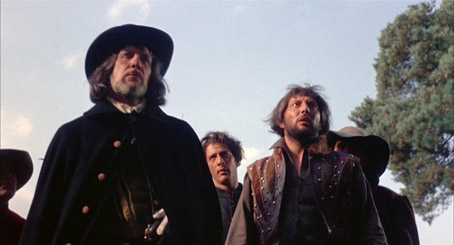
As we shall see, the spared-down freshness of Tom Baker's script and, indeed, much of the film's depth and power, arose, almost accidentally, from the circumstances of its production, in particular the size of the film's budget. But the film owes much, too, to the long-standing friendship of Baker and Reeves. They had grown up together in the Berkshire village of Cold Ash, near Newberry and dabbled in amateur 8mm filmmaking as boys. Later they worked together on Reeves' first schoolboy attempts at filmmaking, Carrion (1958) and Intrusion (1961), and on his second feature The Sorcerers (1967). Reeves, who inherited substantial wealth in his teens, supported Baker during a period of unemployment. Their close friendship and their familiarity with each other's ways of working made a significant contribution to the success of Witchfinder General. Baker grew up as determined to be a writer as Reeves did determined to be a director. Baker was interested in history, landscape and writing; Reeves was interested in Westerns, horror and cinematography.
In a perceptive chapter on Witchfinder General in Light Out for the Territory, Iain Sinclair argues that, "The film's success lies in the tension between Baker's Utopian permissiveness, his feel for the country, and Reeve's demonic fatalism." Sinclair puts it with enigmatic elegance but he may slightly overstate his case. The differences between Baker and Reeves certainly did create a chemistry that drove the film, but their respective predilections were not mutually exclusive; they also complemented one another. I prefer to think that Baker and Reeves traded enthusiasms to the extent that they became shared ones and that the film's extraordinary blend of landscape, horror and history flowed from their collaborative work. Wherever we place the emphasis, Baker and Reeves were certainly a winning combination.
The film was made on a modest budget of £83,000 and the inevitable challenges that imposed drew out the tried-and-tested, improvisational best in Baker and Reeves. On such a budget it was plain that they would have to break with the Hammer horror tradition of studio-bound hokum. The Hammer scene made films that made money while providing a cinematic entry point and apprenticeship for young directors (David Pirie speaks of "infiltration"), but it had no interest in landscape. Baker and Reeves, on the other hand, were drawn to the East Anglian countryside, by love of it as much as by necessity. Their approach to landscape charted a course that would soon be followed by Blood on Satan's Claw (1971) and The Wicker Man (1973).
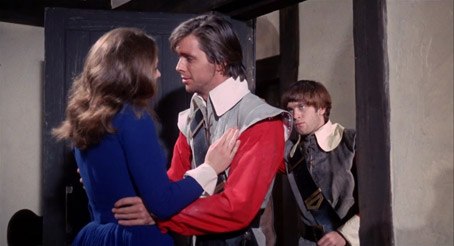
In 2003, an inspired moment of film programming saw Witchfinder General screened alongside Kevin Brownlow's Winstanley and Alan Clarke's Penda's Fen (1975) – at an event (Visionary Landscapes: Folk, Film, Landscape) organised to mark the 125th Anniversary of the Folklore Society. Although working from different sets of motivations and guided by divergent aesthetics, Brownlow, Clarke and Reeves were all interested in the relationship between the past and present, in place and the English landscape. That respect for the Suffolk landscape dovetailed with Reeves' long-standing ambition to make a Western. Reeves loved John Sturges' The Magnificent Seven (1960) almost as much as he loved Don Siegel's The Killers (1963), with which he became increasingly obsessed towards the end of his short life. Witchfinder General is, among many things, an English Western set during a Civil War, featuring horse chases across open country and a clearly delineated contest between good and evil, one in which characters are gunned down and revenge is sweet. Landscape is, of course, an essential component of Westerns.
During pre-production Tom Baker and Michael Reeves walked and drove around Suffolk scouting locations, absorbing the atmosphere emitted by the landscape, and then wrote the script around the places they discovered. Interviewed by John B. Murray for his book The Remarkable Michael Reeves, Baker says: "What struck us was the possibility to make a film partly to do with the English landscape but also to do with movement through the geography of England . . . We did write it around places. We were trying to stretch the landscape a bit." And stretch it they did. Reviewing the film for Time Out in 1971, David Pirie described Witchfinder General as, "One of the most personal and mature statements in the history of British Cinema," adding, "No film before or since has used the British countryside in the same way."
Few films before or since have used British history in the same way either. Michael Reeves has been quoted as saying that he loved horror films and, conversely, that he worked in that genre simply because it offered an easy route in to the industry. His first two features, Revenge of the Blood Beast (1966) and The Sorcerers (1967), fell, as their titles suggest, unashamedly within that genre. Witchfinder General, however, was of a different order and on a different level. The whole atmosphere of the film is underpinned by its struggle for historical authenticity and Reeves' determination to achieve a sense of realism largely absent from his early films. I would argue that the film's force derives not so much from the acts of violence depicted - which seem restrained by modern standards – but, rather, from its generally accurate representation of the circumstances of one of the most barbaric episodes within the bloodiest civil conflict in this island's bloody history. In creating a palpable sense of menace and horror, the film touches on things we would rather forget.
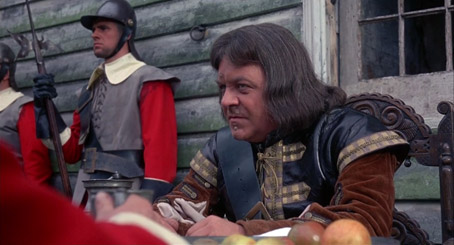
Although it shares many of failings of Ronald Bassett's schlocky 1966 novel, from which it was adapted, Witchfinder General conveys the horrors of history unflinchingly and tellingly, but not gratuitously. It can proudly take its place alongside Kevin Brownlow's Winstanley (1975) and Paul Flannery's TV series The Devil's Whore (2008) as one of the few attempts to approach the English Revolution with anything like the serious attention its importance merits. It is one of the few films to portray the "good old cause" and the common soldiers of the New Model Army in a positive light. Next to Witchfinder General, other films set during the English Revolution contained less truth about the period because they were less interested in the people of those times, let alone the landscape they inhabited. Tellingly Reeves' eye for composition is especially keen when he is framing the faces of crowds and the landscape. Ken Hughes' Cromwell (1970) and Mike Barker's To Kill a King (2003) are well-acted, slickly-produced, big-budget films but they are also detached travesties of truth, mere hagiographies of Cromwell, that lack the vim, vision, intensity and invention of Reeves' low-budget, improvised gem.
It may be because the ideological conflicts of the Civil Wars remain so relevant, it may be because notions of national unity remain so fragile, but it is astonishing, nonetheless, that so few films have dared to cover that time. As a proportion of the adult population, more men died during the Civil Wars than during the First World War. The scale of slaughter and destruction was huge. Over 85,000 Englishmen died fighting; 100,000 died from wounds, starvation or disease; 120,000 were made prisoners of war. 150 towns were damaged or destroyed, over 10,000 homes were burnt down or demolished, 55,000 were made homeless. The loss of life and damage to homes was no less horrific in Scotland and Ireland. For those who lived through the upheavals of 1968 that period must have had particularly powerful contemporary resonances. Audiences at the film's initial screenings would have viewed Witchfinder General with the Vietnam War in the back, if not at the forefront of their minds. Of course, history may not have mattered as much to Michael Reeves as it did to Tom Baker but he made this, his finest film, at a time when rebellion was in the air and when he was contending with demons of his own. Such realities, inevitably, seeped into Witchfinder General. If the film derives much of its force from a general sense of the horror of war, it also reflects the specific horror of Hopkins' witch-hunts. Over a 14-month period, between 1644 and 1647, Hopkins executed over 300 women accused of witchcraft in South East England. The death toll attributable to Hopkins multiplied when the practices outlined in his book The Discovery of Witches (1647) crossed the Atlantic to precipitate further witch-hunts in the Puritan colonies of New England: first in 1648-1663, then, in Salem, in 1692-93.
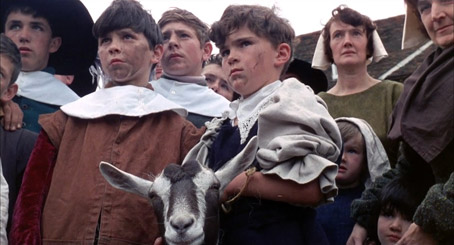
There are glaring historical inaccuracies in Witchfinder General: Hopkins, for example, was a 25 year-old Puritan fanatic at the time of the witch-hunt while Vincent Price was a 56-year old veteran of 75 films. There are also scenes (and screams) we would prefer to cut out: the Tavern scenes are too close to sexist Hammer horror cliché for comfort and the nudity in those scenes (which is absent from the UK version presented here, but is included in the extra features), unlike the film's representations of violence, IS gratuitous. In Michael Reeves' defence it can be argued that bare breasts were largely forced on him by the moneymen at Tigon and American International Pictures. Reeves, honourably, refused to direct the scenes of gratuitous nudity himself; that salacious task was left to Tony Tenser of Tigon and Louis M. Haywood of AIP. Reeves had the last laugh though. He mischievously and amusingly inserted a recognisable wink to the wise into the credits: "Additional Scenes by Louis M. Haywood."
Despite such flaws, and other regrettable if minor examples of artistic license, the film is sufficiently faithful to history to afford those with a compassionate connection to the past a rare opportunity to visit those times. The best aspects of Witchfinder General considerably outweigh its worst. The film is a master class in what can be achieved on a low budget. Producer Phillip Waddilove ably aided Reeves in his attempts to make every penny count. He secured the use of Lavenham Town Square for a small charitable donation of £30 to the local school playing-field fund. He spent just £15 to hire a 'cherry picker' and driver from the Electricity Board, thus saving the cost of an expensive camera crane. Reeves himself was able to secure use of an army range through a friend, in exchange for just a credit. The film was a box office success in Britain and Benjamin Halligan suggests, in his biography Michael Reeves, that the film made $10 million in the U.S. alone. Michael Reeves had a special talent, born of necessity, for achieving great things with limited resources and his hugely talented cast and crew assisted him to that end.
Reeves had persuaded Boris Karloff to play in The Sorcerers and he had his heart set on Donald Pleasence for the role of Hopkins. As part of the finance deal with AIP, though, he was forced, reluctantly, to 'make do' with Vincent Price. He immediately made the mistake of telling Price that Pleasence had been his first choice and the two men, unsurprisingly, didn't get on thereafter. Fortunately, it turned out well for all concerned: Reeves coaxed and chivied a career-best performance from Price, who was never so understated or so menacing. Likewise, Reeves had his heart set on Nicola Paget for the role of Sarah but struck gold when he found Hilary Dwyer, the perfect English Rose. Although Dwyer had appeared in such legendary TV series as The Avengers and The Prisoner, she had never appeared on film. Fortunately, she took to it like a duck to water and is excellent throughout, perhaps as result of a naivety and nervousness on her part that chimed with the part she was playing. Ian Ogilvy, Nicky Horne and Robert Russell are equally excellent and there are superb cameos from renowned TV actors hauled in with an eye to sales: Rupert Davies, John Wymark and Wilfrid Brambell, enthusiastically reprising his Steptoe role as a cheeky horse trader. Brambell's appearance may not have added much to the overall success of the film but it provides us with an interesting moment of nostalgic recognition and reminds us that the film is not without humour. Reeves was a serious filmmaker but he didn't take himself so seriously he couldn't be playful.
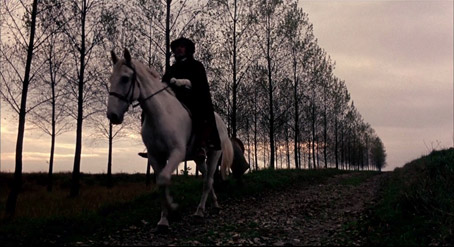
Fortune favours the brave and Michael Reeves was certainly fortunate to have John Coquillon as his cinematographer and Paul Ferris as his composer. John Coquillon, a Québécois, was also tuned in to Reeves' make-do-and-mend, improvisational style. He had worked on wildlife photography so he was well suited to a film in which the Suffolk landscape plays such an important part. Coquillon creates a number of images that stake a claim to high art, for instance, a superb static shot of Hopkins riding towards the camera, leaving a row of tall trees silhouetted against the evening sky in his wake. Coquillon went on to produce work of similarly high quality for Sam Peckinpah in Straw Dogs (1971), Pat Garrett and Billy the Kid (1973) and Cross of Iron (1977). Everyone involved in the production of Witchfinder General was aware how tight money was; perhaps none more so than Paul Ferris, who composed the music for all three of Michael Reeves features and who exemplifies the commitment of cast and crew to the film. For the first vital recording session he used a 55-piece orchestra, which he partly paid for out of his own salary. He had listened to Greensleeves prior to composing the film's score and there are echoes of that folk song in the recurring musical motif that threads the film, as Ferris acknowledged when he said: "I was aiming for . . . a feeling of Greensleeves, because it is for England what Danny Boy is for Ireland."
Not everybody could respond to best qualities in the film, many of which were essentially English. Cahiers du cinéma certainly didn't, describing Witchfinder General as: "an hour and a half of emptiness redeemed by 90 seconds of content at the end." The film is far from empty. It is, in fact, packed with incident, excitement and excellence. It is a film much greater than the sum of its parts; a fascinating, haunting, expertly crafted film that continues to be talked about in tones of hushed reverence.
The first question with any film from years past that has been remastered for Blu-ray is whether the results live up to expectations and are worth the upgrade from any previous DVD release. It is with some pleasure that I can confirm that the answer is a resounding yes. Although a few notches short of modern digital perfection due to some occasional image flickering and a few residual dust spots, the level of detail is excellent, the contrast is sometimes (though not always) perfectly balanced, and the colour palette captures the richness of the red military jackets and blue helmet plumes without over-saturating the sedate greens of the countryside setting. Black levels are solid throughout, and despite initial suspicions to the contrary, shadow detail is generally stronger than on previous home video versions, or, indeed, the alternative scenes included on this disc. There is also no trace of the quality shift that identified the restored scenes in the previous DVD incarnation of this director's cut.
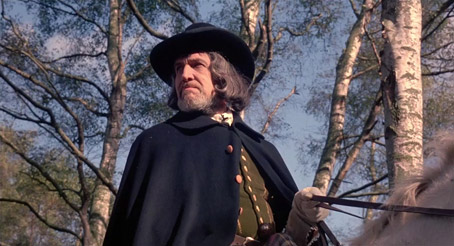
The DTS-HD mono 2.0 track also lives up to expectations, being clear of any background hiss, crackle or other sundry signs of age and damage. There is a slight narrowing of range consistent with the film's age and budget, but no hint of distortion even on louder music or the memorable final screams.
A lack of English subtitles for the hearing impaired is a surprising omission for such an otherwise comprehensive package.
Commentary
Benjamin Halligan, author of the British Film Directors volume on Michael Reeves, and Reeves' former friend and colleague Michael Armstrong, provide a most engaging and comprehensive mix of research, opinion and personal recollections. Likely to prove particularly useful to anyone new to the film or its short-lived director, a good deal of ground is covered here, including the opening sequence (every picture under the credits was apparently scripted), the concept of the film as an English western, the film's strong sense of communal isolation, Reeves' resistance to the casting of Price and his battles with production companies Tigon and AIP, the role played by the violence and the censorship problems it caused, and, perhaps inevitably, Reeves' tragically young death, and this is just a small sampling of the topics discussed. Initially it's Armstrong's memories of working with Reeves that really command your attention, but Halligan contributes plenty of worthwhile facts and opinions of his own, though at one point his fellow commentator does suggest he might be finding meaning where none was intended. And there's not a dead spot in the whole thing. A fine commentary.
Theatrical Trailer (2:29)
A breezy trailer with urgent narration that assures us that the picture was "filmed in authentic detail and photographed with piercing realism against the actual background of peaceful villages and quiet countryside" and that urges you to "Be the first to see it, be the first to talk about it."
Alternate Opening and Closing Credits (6:23)
The version of the opening and closing credits used on the American release. The key difference is the inclusion of opening and closing quotes read by Vincent Price from Edgar Allen Poe's poem The Conqueror Worm, which is how the film was titled in the US, presumably in an attempt to link the film to Corman's Poe adaptations, which also starred Price. These alternative credits are referred to in the commentary so are a useful inclusion.
Alternate Scenes From Export Version (5:08)
A five minute sequence spanning a number of short scenes revolving around Stearne's tavern drinking that were filmed in two versions, one for the domestic market, and a slightly raunchier version (the tavern women are topless) for European and American release. This also gets discussed in the commentary.
Vincent Price on Aspel & Company (10:07)
Price makes a 1984 appearance on a UK chat show hosted by nice guy presenter Michael Aspel and is an absolute riot, topping off a number of witty and entertaining anecdotes with the comically deadpan claim that the thing that really frightens him is talk shows, and that he's been watching Aspel like a hawk and waiting for him to ask an intelligent question. Witchfinder General doesn't even get a mention, but for its entertainment value alone this is a most welcome inclusion. The original 4:3 aspect ratio has been cropped to 16:9, but not in a harmful way.
The Blood Beast: The Films of Michael Reeves (23:50)
A cod-60s title sequence that suggests this is part of a series called Eurotika! makes way for a concise and engaging portrait of director Michael Reeves, covering his entire brief career in filmmaking, from his teenage film projects to his first steps in the American film industry (the story of how he landed his first job gives a clear idea of how determined Reeves was to break into the business). Several of his key collaborators are interviewed, including two of his long term close friends, writer Tom Baker and actor Ian Ogilvy, and the story of the on-set collision between Reeves and Price that finally won Price over is told better here than on the commentary track.
Intrusion (10:25)
A silent short film made by Michael Reeves in 1961 in which two leather jacketed hoodlums – Reeves himself and his friend and Witchfinder General co-writer Tom Baker – break into a house and menace the female occupant but end up being killed by her and her husband. Primitive in its technique and unclear in its storytelling, it's nonetheless a valuable find given Reeves' brief career and the interest in his work and the development of his cinematic style. This can be watched with or without a commentary by Benjamin Halligan and Michael Armstrong, who flit between jocular comments, memories and factual information on Reeves and the film.
Bloody Crimes: Witchcraft (23:39)
Presenter Bryan McNerney, who looks like a cross between a Hell's Angel and a wrestler, hosts an over-dramatic (complete with the sort of music score you might expect to hear when touring the London Dungeon) but informative and always interesting look back at how a ruthless determination to stamp out the imaginary crime of witchcraft led to scores of people being wrongly accused, tortured and executed in 17th Century England. Appropriately it includes a portion on Matthew Hopkins and John Stearne, providing some useful background on truth behind the drama.
Gallery (2:00)
A rolling gallery, set to music, of production stills, posters and pages from the press notes.
Witchfinder General is a legendary cult classic set during the English Revolution. The film's daring young director Michael Reeves took the genres of Historical Drama, Horror and the Western where they had never been before. Reeves had a flair for improvisation and innovation, and his groundbreaking treatment of landscape and history lend this landmark film an atmosphere and power all of its own. Witchfinder General is sometimes silly, often annoying but never dull. It offers a compelling glimpse into a violent period that changed the world and into the barbarous practice of witch-hunts. Brilliantly directed, expertly acted and superbly shot in beautiful countryside Witchfinder General is admired the world over. This release marks a welcome return for a film too little seen by too few. It's never looked better outside of the cinema and is backed up by a comprehensive and well chosen set of extra features. Recommended.
|